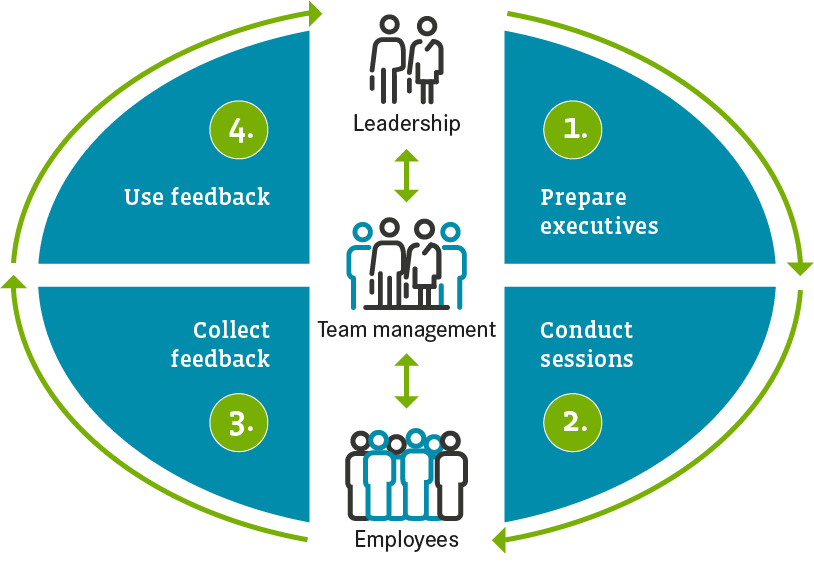Digital transformation poses challenges to enterprises—but the new digitally enabled work environment also offers amazing opportunities. It is up to the managers to provide their staff with competent guidance and support on this path and place them at the center of organizational progress. To do so, an ongoing dialog needs to be ensured.
The new, flexible ways of working of New Work also bring with them uncertainties that managers and staff alike need to handle. Because—at the latest since the pandemic—a hybrid working model has replaced the way we used to work traditionally. This creates new dynamics.
Managers need to guide and motivate their teams, also remotely. On the one hand, this is facilitated by technical means of communication made available by the digital transformation. On the other hand, however, the management style also needs to be sustainably adjusted to the new situation.
The Future Organization Report 2021 showed that only the agile interaction of excellent staff and digital processes will lead a business to successful outcomes. This requires a critical analysis of the facts and circumstances: How should I lead my staff? What resources are available to me and to them? Where should I start to meet the new needs of my workforce? An open corporate culture with feedback loops, and last but not least, an agile mindset, are important stepping stones towards successful employee centricity.
Servant leadership: Leading in the service of the workforce
Leaders not only need to empower employees to embrace digital transformation, they also need to set a good example. After all, inadequate executive support is the main reason (60%) why transformation projects fail. But how can the management become a role model?
Well, first and foremost, companies should promote collaboration across teams and areas of competence, since many approaches to solutions for the problems encountered on the path to digital transformation are already available—they only need to be discovered. In doing so, it is always a good idea to also look beyond the boundaries of the own organization. External consultants can also provide support, for example by explaining everyday leadership challenges in the digital workplace on exemplary scenarios and providing hands-on solutions.
In addition, leaders should set a common goal for staff to enable them to independently act in the interest of the company. A management that leads effectively will in turn experience ideal support. And it seems like they have some catching up to do in this area: A quarter of FOR respondents said they lacked tangible targets. For this reason, a targeted top-down and bottom-up consultation process is required.
Solutions and ideas from the dialogue cycle
Even a virtual team thrives on a sense of community. Thus, even a virtual management needs to be able to keep track of the situation and delegate control, as necessary. This requires mutual trust, stable structures and reliability. All this can only be achieved through a constant flow of information and transparency—in all directions.
A corresponding dialog cycle enables an open, sustainable feedback culture, especially with regard to upcoming challenges such as the digital as well as hybrid restructuring of a company. Both the necessities as well as the goals and benefits should be transparently communicated. In doing so, management needs to speak with one voice and at the same time obtain feedback from their staff.
Because: The management can learn from their staff. The dialog ensures that managers and their staff are actively engaging in the change process, that suggestions for improvement are more readily accepted, and progress is more readily adapted.
A feedback culture that is alive also openly addresses problems, and this is welcomed by 82 percent of managers and employees, according to the Future Organization Report. This approach builds on trust and positively affects the company's business performance. In this way, the challenges posed by New Work and the New Normal are overcome in a collaborative effort.
Four-step dialog cycle
1 & 2: Top-down communication; 3 & 4: Bottom-up communication

Leading the way to digitization
The process to develop digital remote leadership makes it necessary to classify as well as specify the individual characteristics and challenges. The management should not just communicate the changed working conditions to their workforce, but also understand and live them in an exemplary manner. Successful leaders understand what elements will be needed for the future and how they can sustainably support their team on the path to digitization by serving as a role model.

